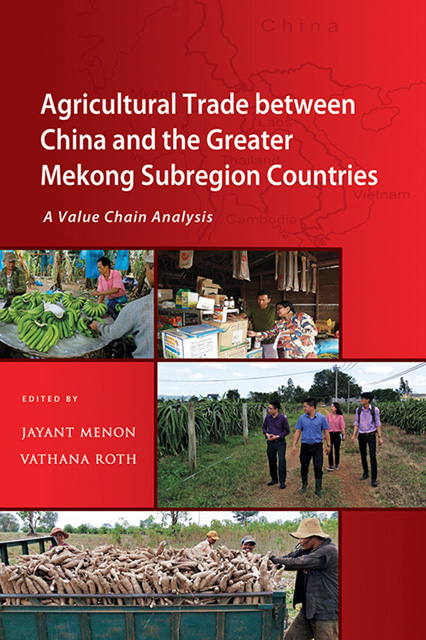Book contents
- Frontmatter
- Contents
- List of Tables
- List of Figures
- List of Annexes
- Foreword
- Preface
- Acknowledgements
- Abbreviations and Acronyms
- The Contributors
- 1 Agricultural Trade between China and the Greater Mekong Subregion Countries: An Overview
- 2 Economic Structural Change in China and the Implications for Agricultural Trade in the Lancang-Mekong Region
- 3 Agricultural Exports from Thailand to China: A Value Chain Analysis of Cassava and Durian
- 4 Agricultural Exports from Cambodia to China: A Value Chain Analysis of Cassava and Sugarcane
- 5 Agricultural Exports from Laos to China: A Value Chain Analysis of Rice and Cavendish Banana
- 6 Agricultural Exports from Myanmar to China: A Value Chain Analysis of Maize
- 7 Agricultural Exports from Vietnam to China: A Value Chain Analysis of Dragon Fruit and Coffee
- Index
7 - Agricultural Exports from Vietnam to China: A Value Chain Analysis of Dragon Fruit and Coffee
Published online by Cambridge University Press: 30 June 2023
- Frontmatter
- Contents
- List of Tables
- List of Figures
- List of Annexes
- Foreword
- Preface
- Acknowledgements
- Abbreviations and Acronyms
- The Contributors
- 1 Agricultural Trade between China and the Greater Mekong Subregion Countries: An Overview
- 2 Economic Structural Change in China and the Implications for Agricultural Trade in the Lancang-Mekong Region
- 3 Agricultural Exports from Thailand to China: A Value Chain Analysis of Cassava and Durian
- 4 Agricultural Exports from Cambodia to China: A Value Chain Analysis of Cassava and Sugarcane
- 5 Agricultural Exports from Laos to China: A Value Chain Analysis of Rice and Cavendish Banana
- 6 Agricultural Exports from Myanmar to China: A Value Chain Analysis of Maize
- 7 Agricultural Exports from Vietnam to China: A Value Chain Analysis of Dragon Fruit and Coffee
- Index
Summary
INTRODUCTION
China is the second-largest export destination for Vietnam’s exports, with total export value increasing tenfold from around US$2 billion in 2000 to nearly US$22 billion in 2016, of which agricultural products accounted for 35 per cent. Total import-export turnover between the two countries increased from US$71.9 billion in 2016 to US$93.6 billion in 2017. The total value of Vietnam’s trade with China amounted to 22 per cent of the value of its total trade with the world. More importantly, the ratio of Vietnam’s trade with China to its total trade has been steadily increasing, with agricultural exports playing a significant role in overall export growth. China’s market share of Vietnam’s exports rose from about 6 per cent to 7 per cent between 2002 and 2008 to 26 per cent in 2017. This increase in China’s share of exports reflects an increase in Vietnam’s major agricultural exports in particular and export products in general.
The total value of agricultural products exported from Vietnam to China grew significantly from US$3.8 billion in 2014 to US$4.5 billion in 2016. Rice, fresh fruit and coffee are Vietnam’s top three exports by value. The value of rice exports remained relatively stable at around US$700 million throughout 2014–16, whereas the value of fresh fruit exports fluctuated, peaking at US$811 million in 2015 from US$627 million in 2014 then declining to US$533 million in 2016 (Atlas of Economic Complexity 2018). However, the value of fresh fruit exports was still vastly higher than that of coffee exports, which in 2014 stood at US$90 million.
Of special interest to Vietnam is the growing demand from China’s expanding middle class for fresh fruit and coffee. Between 2012 and 2015, the total value of Vietnam’s fresh fruit exports to China almost doubled, from US$442 million to US$861 million. In 2017, China imported about US$2.5 billion worth of fresh tropical fruit from Vietnam, representing an increase of 179 per cent since 2011 (Kubo and Sakata 2018). This surge in fruit exports coincided with an equally remarkable surge in Vietnam’s coffee exports to China, which in 2016 reached US$330.1 million, a heady 226 per cent increase in just two years.
- Type
- Chapter
- Information
- Agricultural Trade between China and the Greater Mekong Subregion CountriesA Value Chain Analysis, pp. 256 - 294Publisher: ISEAS–Yusof Ishak InstitutePrint publication year: 2022



